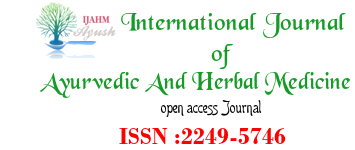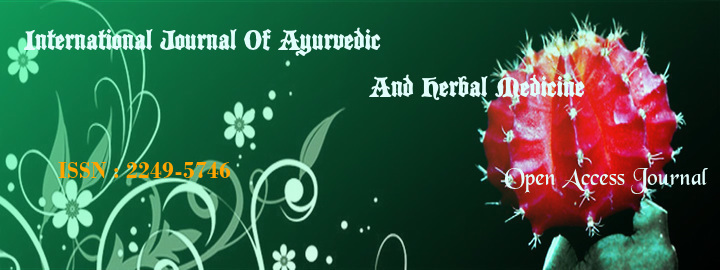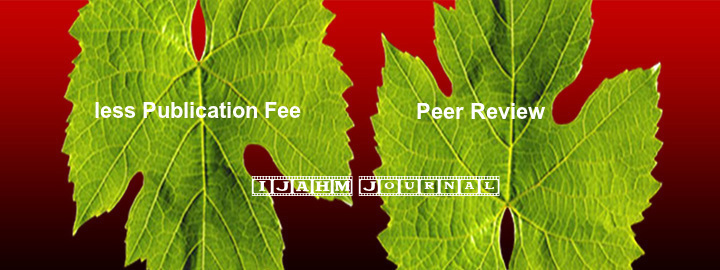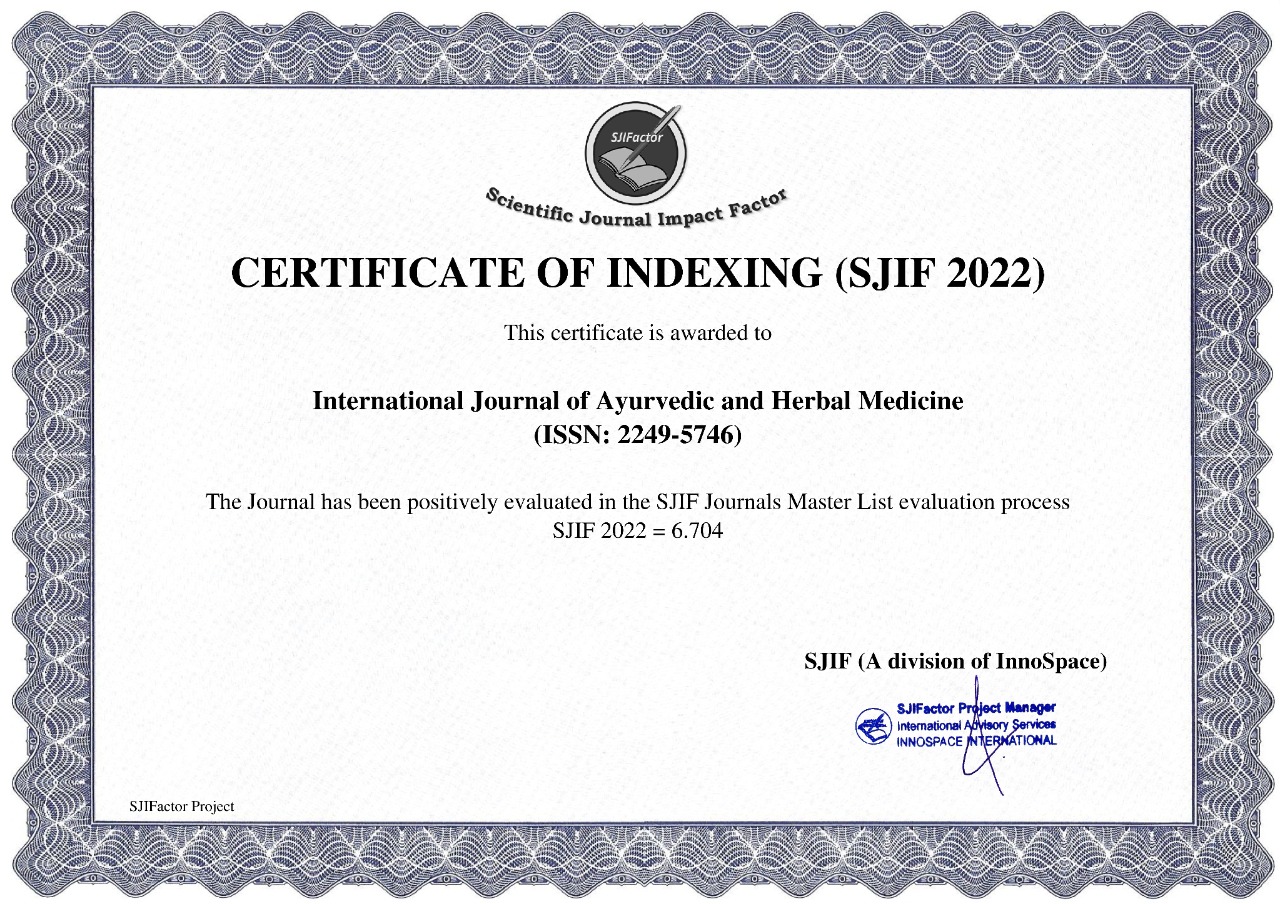


Borokar A. A.1*, Dr. Pansare T. A.2
1. PG Scholar (Dravyaguna), Government Ayurvedic College, Osmanabad, Maharashtra.
2. Associate professor of Dravyaguna Department, Government Ayurvedic College,
Osmanabad, Maharashtra. 413501
Abstract
Ayurveda is a traditional system of medicine in which herbal therapies were used systematically. Ashoka i.e.Saraca asoca (Roxb.) Wilde belonging to Caesalpinaceae subfamily of the Legume is one of the indigenous plants with lots of traditional significance. The all parts of this plant are considered pharmacologically important and has especially been used to manage various gynecological disorders like menorrhagia, leucorrhoea, dysfunctional uterine bleeding. Saraca asoca has been reported to contain phytoconstituents like flavoinoids, steroids, glycosides, saponins, tannins, carbohydrates, proteins along with lot of pharmacological activities such as spasmogenic, oxytocic, uterotonic, anti-bacterial, anti-menorrhagic, anti-cancer, anti-esterogenic, anti-progestational, dermatoprotective, anti-mutagenic and genoprotective activities. This review describes the socio-ethnobotanical usage, different reported pharmacological actions, phytoconstituents and pharmacognostical information about Ashoka herb. The information about lacunae in improving the Pharma worth of Ashok such as lack of tissue culture techniques in Ashoka planting has been also gathered. Saraca asoca is the ideal candidate for screening of its endophytes for pharmaceutical related compounds. It is hoped that this review will provide sufficient, ideal and unique information under one umbrella and also give new direction for the researchers and pharmaceutical industry to extend the Pharma worth of this natural product.
Keywords:
Ashoka, Phytoconstituents, pharmacology, pharmacognocy, adulteration, endophytes, gynaecological disorder.
References
1. P. Pradhan, L. Joseph et al. Saraca asoca (Ashoka): A Review. Journal of Chemical and Pharmaceutical Research, 2009, 1(1): 62-71
2. https://en.m.wikipedia...rg/wiki/Saraca_asoca. [Cited- 2017 march 02]
3. Pandit Kashinath Pandey and Dr. Gorakhanatha Chaturvedi. Vidyotini Hindi Commentory Charak Samhita-1 (Hindi Translation). Varanasi; Chaukhamba Bharati Academy. Reprint 2013. p. 96.
4. Ambikadatta Shastri. SushrutSamhita (Hindi Translation).Varansi: Chaukhamba Bharati Academy; 2005, p.184.
5. Bhav mishra, Gangasahay Pande. (editor), Krushnachandra Chunekar. Bhavprakash Nighantu (Hindi Translation). 7th edition, Varanasi; Chaukhamba Bharati Academy. 1986, Reprint-2015, p.487-488.
6. Shri. Bapalal, G. Vaidya. Nighantu Adarsha-1. 2nd ed. Varanasi; Chaukhamba Bharati Academy. 1998. P.387
7. Dr. Bramhananda Tripathi. Astanga Hrdayam of Srimadvagbhata (Hindi Translation). Delhi: Chaukhamba Sanskrit Pratishthan; reprinted 2011, p.808.
8. K. R. Kirtikar and B. D. Basu. Indian Medicinal Plants (Vol-2). 2nd ed. Dehradun; International book distributors.1999. p. 882-884.
9. K.M. Nadkarni. Indian Materia Medica (Vol I). 2nd ed. Mumbai; Popular Prakashan Private Limited. 1927; Reprinted 2005. p.1104-1106.
10. The Wealth of India. Vol-4. National institute of science communication. New delhi. 1972; reprinted 1999. P 232-234
11. PK Warrier, VPK Nambier, PM Ganpathy. Some important medicinal plants of the western ghats, India - A Profile. International Development Research Centre, New Delhi. 2000; 343-360.
12. TK Biswas, PK Debnath. Ind J Hist Sci, 1972, 7(2): 99-114.
A. Molina. Enumeration de la Plants de Honduras. Revista Ceiba.2013, 19(1): p.1-118.
13. Prof. Priyavrat Sharma. Dravyaguna Vidnyan (vol-2). Varanasi; Chaukhamba Bharati Academy. Reprint 2015. P.617-619.
14. Dr. Indradeva Tripathi. Chakradatta of Chakrapanidatta. Vaidayaprabha Hindi Commentory. Varanasi. Chaukhambha Sanskrit santhan; Reprint 2005: p.377.
15. M. Ali. Pharmacognocy. CBS Publishers and Distributors. New Delhi. 2008; p.668-669.
16. http://www.herbalcureindia.com/herbs/asoka.htm
17. http://ayurveda-foryou.com/ayurveda_herb/ashok.html
18. Satish A. Bhalerao et al. Saraca asoca (Roxb.), De. Wilde: An overview. Annals of plant sciences. 2014; 3(7): p.770-75.
19. Anonymous. The Ayurvedic Pharmacopoeia of India (Part I, vol 1), First edition 1990, Reprinted 2001. P.17-18.
20. Jayita Saha, Taniya Mitra, et al. Phytoconstituents and HPTLC analysis in Saraca asoca (Roxb.) Wilde. International Journal of Pharmacy and Pharmaceutical Sciences. 4(1); 2012: p.96-99.
21. SC Pal, AP Maiti et al. Antibacterial activity of flower and flower buds of Saraca indica. Indian J Med Res. 1985; 82(2): p.188-89.
22. V. Maruthappan, KS. Shree. Antiulcer activity of aqueous suspension of Saraca indica flower against gastric ulcer in albino rats. Journal of Pharmacy Research. 2010; 3(1): p.17-20.
23. S. Ghosh, M. Majumder et al. Saracin: A Lactin from Saraca indica seed Integument Induces apoptosis in Human T-Lymphocytes. Archives of Biochemistry and Biophysics. 1999; 371: p. 163-68.
24. N. Mathew, MG Anitha et al. Larvicidal activity of Saraca indica, Nyctanthes arbor-tristis, and Clitoria ternatea extracts against three mosquito vector species. Parasitology Research. 2008; 104: p.1017-25.
25. T.R. Cibin, D.D. Gayathri, A. Abraham. Chemoprevention of skin cancer by the flavonoid fraction of Saraca asoca. Phytotherapy Research. 2010; 24: p.666-72.
A. mishra, A. Kumar et al. Phytochemical and Pharmacological importance of Saraca indica. Int. J. Pharm. Chem. Sci. 2013; 2: p.1009-1013.
26. S. Panchawat and S. S. Sisodia. In vitro antioxidant activity of Saraca asoca Roxb. De Wilde stem bark extracts from various extraction processes. Asian J. Pharm. Clin. Res. 2010; 3: p.231-33.
27. S. K. Sadhu, A. Khatun et al. Lignin glycosides and flavonoids from Saraca asoca with antioxidant activity. J. Nat. Med., 2007; 61: p.480-82.
A. Gahlaut, A. Shirolkar et al. beta-sitosterol in different parts of Saraca asoca and herbal drug ashokarishta: qualitative-quantative analysis by liquid chromatography-mass spectrometry. J. Adv. Pharm. Technol. Res., 2013; 4: p.146-50.
28. M. K. Mukhopadhyay and D. Nath. Phytochemical screening and toxicity study of Saraca asoca bark. Int. J. Phytomedi., 2011; 3: p.498-505.
A. Shirolkar, A. Gahlaut et al. Quantitative analysis of catechins in Saraca asoca and correlation with antimicrobial activity. J. Pharm. Anal., 2013; 3: p.421-28.
29. S. Kalakotla, G. K. Mohan et al. Screening of Saraca indica (Linn.) medicinal plant for antidiabetic and antioxidant activity. Der. Pharm. Lett., 2014; 6: p.227-33.
30. F. Ahmad, L. Misra et al. Anti-inflammatory flavonol glycosides from Saraca asoca bark. Nat. prod. Research. 2015; 23: p.1-4.
31. G. Somani and S. Sathaye. Bioactive fraction of Saraca indica prevents diabetes induced cataractogenesis: an aldose reductase inhibitory activity. Pharmacogn. Mag., 2015; 11: p.102-110.
32. J. Saha, S. Mukherjee, K. Gupta et al. HPTLC analysis of antioxidants present in different parts of Saraca asoca (Roxb.) de Wilde. J. Pharm. Res., 2013; p.1-6.
33. W. Samee and S. Vorarat. Simultaneous determination of gallic acid, catechin, ellagic acid and quercetin in flower extracts of Michelia alba, Caesalpinia pulcherrima and Nelumbo nucifera by HPLC. Thai. Pharm. Health Sci. J., 2007; 2: p.131-37.
A. K. Pandey, V. Ojha et al. Phytochemical evaluation and radical scavenging activity of Bauhinia variegata, Saraca asoca and Terminalia arjuna barks. Res. J. Phytochem., 2011; 5: p.89-97.
A. Jain, S. Sharma and V. Saini. Hypolipidemic, hypoglycemic and antioxidant potential of Saraca asoca ethanolic leaves extract in streptozotocin induced-experimental diabetes. Int. J. Pharm. Sciences. 2013; 5: p.302-305.
34. M. Gupta, S. Sasmal and A. Mukherjee. Therapeutic effects of acetone extract of Saraca asoca seeds on rats with adjuvant-induced arthritis via attenuating inflammatory responses. ISRN Rheumatol. 2014; 2004: p.1-12.
35. N. Sarojini, S. A. Manjari and C. C. Kanti. Phytochemical screening and antibacterial activity study of Saraca indica leaves extract. Int. Res. J. Pharm., 2011; 2: p.176-79.
B. Preeti, A. Bharti et al. A review on Saraca indica plant. Int. Rrs. J. Pharm. 2012; 3: p.80-84.
36. Anshu Bala Verma, Arunbala Saroj et al. Review on Ethnobotanical Importance of Saraca indica. Int. J. Pharma. Res. Scholars. 2014; 3(1): p.313-21.
37. http://commons.wikimedia.org/wiki/Category:Saraca_indica.
38. http://www.chakrapaniayurveda.com/ashoka.html.
39. T. B. Middelkoop and R. P. Labadie. Int. J. Crude Drug Rec., 1986; 24(1): p.41-44.
40. M J. Bhandary, K. R. Chandrasekhar and K.M.K averiappa. J. Ethnopharmacol. 1995; 47(3): p.149-58.
41. Y. Kumar, K. Haridasan and R. R. Rao. Bull. Bot. Surv. India. 1980; 22(1/4): p.161-65.
42. T. B. Middelkoop and R. P. Labadie. Z. Naturforch Ser., 1985; 40(6): p.855-57.
43. T. B. Middelkoop and R. P. Labadie. Z. Naturforch Ser c 40., 1985; 718: p.523-26.
44. G. V. Satyavati, D. N. Prasad et al. Ind. Journal of Medical Research., 1970; 58: p.947.
45. J. C. Saha, E. C. Savini and S. Kasinathan. Ind. Journal of Medical Research. 1961; 49: P.130-151.
C. R. Karnick. Acta Phytother. 1970; 17: p.181.
46. M. A. Khan, T. Khan and Z. Ahmad. Fitoterapia. 1994; 65(5): p.444-46.
D. John. International Journal of Crude Drug Research. 1984; 22(1): p.17-39.
47. S. P. Son. Curr Sci., 1963; 32: p. 502-503.
48. M. Ali. Pharmacognosy and Phytochemistry. Career publication. Nashik. 2003; p.269-270.
49. S. C. Pal, A. P. Maiti et al. Ind. Journal of Medicinal Research. 1985; 82(2): p.188-189.
50. S. R. Jain, S. N. Sharma. Plant Med., 1967; 15(4): p.439-442.
A. Singh, S. Singh, B. K. Sarma et al. Internet J Alternative Med., 2009; 6(2): p.1-20.
51. R. Dabur, A. Gupta, T. K. Mandal et al. Antimicrobial activity of some Indian medicinal plants. Afr. J. Trad. Cam., 2007; 4(3): p.313-18.
52. S. Rajan, J. Johnson, J. Selvichristy. J. Sci. Trans. Environ., 2008; 1(3): p.149-151.
53. J. Annapurna, U. T. Bhalerao, D. S. Iyengar. Fitoterapia., 1999; 70: p.80-82.
54. N. Seetharam, H. Sujeeth, et al. Ind. J. P. Sci., 2003; 65(6): p.658-59.
55. N. Mathew. M. G. Anitha et al. Paracitol Res., 2009; 104: p.1017-1025.
56. S. K. Mitra, S. Gopumadhavan et al. Uterine tonic activity of U-3107(even care), a herbal preparation in rats. Indian Journal of Pharmacology. 1999; 31: p.200-203.
A. Verma et al. Analgesic activity of various leaf extracts of Saraca indica Linn. Der pharmacia Lettre. 2010; 2: p.352-57.
57. N. K. Yadav et al. Saraca indica bark extract shows in vitro antioxidant, antibreast cancer activity and does not exhibit toxicological effects. Oxid. Med. Cell. Longev. 2015; doi: 10.1155/2015/205360.
58. T. R. Cibin, D. G. Devi and A. Abraham. Chemoprevention of two-stage skin cancer in vivo by Saraca asoca. Integr. Cancer. Ther. 2012; 11: p.279-286.
59. S. Nayak, A. M. Sahoo et al. Antibacterial activity of Saraca indica leaves extract. IJPRD. 2011; 3(3): P.160-63.
60. S. acharya, A. patra, K. B. Prasanta. Evaluation of the antimicrobial activity of some medicinal plants against enteric bacteria. Tropical journal of pharmaceutical research. 2009; 8(3): p.231-237.
E. Preethi and K. Krishnakumar. Anti-inflammatory activity of the barks of Saraca indica Linn. Pharmacology Online. 2011; 2: p.657-62.
61. K. N. V. C. Lakshmi, M. Madhuri, S. Anwar et al. Evaluation of antiulcerogenic activity of various extracts of Saraca indica bark on aspirin induced gastric ulcers in albino rats. Int. J. Res. Pharm. Chem. 2013; 3: p. 753-58.
62. C. Y. Ahmad. A study on the antiarthritic and antiulcer activities of Saraca indica bark in rats and mice. Thesis, Department of pharmacology. V. L. College of Pharmacy, Raichur, Karnataka, India. Abstr. 2011, p.14. Discussion; p. 147-148.
63. V. Maruthappan and K. Sakthi Shree. Antiulcer activity of aqueous suspension of Saraca indica flower against gastric ulcers in albino rats. J. Pharm. Res., 2010; 3(1): p.17.
64. N. Seetharam, H. Sujeeth et al. Antibacterial activity of Saraca asoca bark. Indian J. Plant Sci., 2003; 65: p.658-59.
65. N. Sarojini, S. A. Manjari and C. C. Kanti. Phytochemical screening and anti-helminthic activity study of Saraca indica leaves extract. Int. Res. J. Pharm., 2011; 2: p.194-97.
66. S. Nayak, A. Sahoo, Manjiri, C. K. Chakraborti. Phytochemical screening and anti- helminthic activity study of Saraca indica leaves extracts. IRJP. 2011; 2(5): P.194-97.
67. K. P. Manjunath, H. Shivakumar, T. Prakash et al. Antihelmintic activity of roots of Swertia chirata. Ind. J. Nat. Prod. 2006; (1): p.8-10.
68. T. K. Pal, S. Bhattacharyya and A. Dey. Evaluation of antioxidant activities of flower extract (fresh and dried) of Saraca indica grown in West Bengal. Int. J. Curr. Microbiol. Appl. Sci., 2014; 3: p. 251–259.
69. M. A.Mir, S. S. Sawhney and S. Kumar, Comparative study upon the antioxidant potential of Saraca indica and Pterospermum acerifolium. J. Chem. Pharm. Res., 2012; 4: p.4716–4720.
A. Prathapan, S. V. Nampoothiri, S. Mini and K. G. Raghu, Antioxidant, antiglycation and inhibitory potential of Saraca asoca flowers against the enzymes linked to type 2 diabetes and LDL oxidation. Eur. Rev. Med. Pharmacol. Sci., 2012; 16: p. 57–65.
70. S. Katiyar, D. Patidar, S. Gupta et al. Some Indian traditional medicinal plants with antioxidant activity: a review. Int. J. Innovat. Res. Sci. Eng. Technol. 2013; 2: p.7303–7314.
71. S. Kumar, S. Narwal, D. Kumar, et al. Evaluation of antihyperglycemic and antioxidant activities of Saraca asoca (Roxb.) De Wild leaves in streptozotocin induced diabetic mice. Asian Pac. J. Trop. Med., 2012; 1: p.170–76.
72. S. Khatoon, N. Singh, S. Kumar et al. Authentication and quality evaluation of an important Ayurvedic drug – Ashoka bark. J. Sci. Ind. Res., 2009; 68: p.393–400.
A. Verma, G. K. Jana, S. Sen et al. Pharmacological evaluation of Saraca indica leaves for central nervous system depressant activity in mice. J. Pharm. Sci. Res., 2010; 2(6): p.338–343.
F. Yadav, V. K. Garg, N. Thakur et al. Locomotor Activity of methanolic extract of Saraca indica bark. Adv. Biol. Res., 2013; 7: p.1–3.
A. Verma, K. R. J. Houtem, Raja et al. Pharmacological evaluation of Saraca indica leaves for CNS depressant activity in mice. Journal of pharm sci. Res., 2010; 2(6): p338-43.
73. S. N. Begum, K. Ravikumar and D. K. Ved. ‘Asoka’- an important medicinal plant, its market scenario and conservation measures in India. Curr. Sci., 2014; 107: p.26-28.
74. D. Godara, V. Kaushik et al. A method of isolation of Capparisterol from Capparis decidua and antinephrolithiasis activity. Am. J. Adv. Drug. Del. 2015; 3: p.86-94.
75. L. D. Kapoor. Handbook of Ayurvedic Medicinal Plants. 2001, 1st edi. p.298.
76. D. Nag, M.Ghosh and A. Mukherjee. Antimutagenic and genoprotective effects of Saraca asoca bark extract. Toxicol. Indian Health. 2013; 8: p.696-703.
77. T. Mukherjee, S. Chowdhury, A. Kumar et al. Saracoside: a new lignin glycoside from Saraca indica, a potential inhibitor of DNA topoisomerase IB. Nat. Prod. Commun. 2012; 7: p.767-69.
78. R. J. Rodriguez, Jr. J. F. White, A. E. Arnold et al. Fungal endophytes: diversity and functional roles. New Phytol., 2009; 182: p.314–330.
79. R. Jansen, and T. S. Murali, Fungal endophytes and bioprospecting. Fungal Biol. Rev., 2009; 23: p.9–19.
80. P. Jain, V. Aggarwal, A. Sharma et al. Isolation, production and partial purification of protease from an endophytic Acremonium sp. J. Agric. Tech., 2012; 8: p.1979–89.
81. P. Jain, V. Aggarwal, A. Sharma et al. Screening of endophytic fungus Acremonium sp. for amylase production. J. Agric. Tech., 2012; 8: p.1353–64.
82. M. V. Jinu, C. K. Gini and C. Jayabaskaran. In vitro antioxidant activity of cholestanol glucoside from an endophytic fungus Lasiodiplodia theobromae isolated from Saraca asoca. J. Chem. Pharm. Res., 2015; 7: p.952–62.
83. M. V. Jinu, C. K. Gini and C. Jayabaskaran. Modulating the biosynthesis of a bioactive steroidal saponin, cholestanol glucoside by Lasiodiplodia theobromae using abiotic stress factors. Int. J. Pharm. Pharm. Sci., 2015; 7(7): p.114–17.
84. M. V. Jinu and C. Jayabaskaran. Media optimization for the production of a bioactive
85. Steroidal saponin, cholestanol glucoside by Lasiodiplodia theobromae. Eur. J. Exp.
86. Biol., 2015; 5(4): p.28–36.
87. M. V. Jinu and C. Jayabaskaran. Diversity and anticancer activity of endophytic fungi associated with the medicinal plant Saraca asoca. Curr. Res. Env. Appl. Mycol., 5(3): p.169-79.
B. Beena and V. V. Radhakrishnan. Quality assessment evaluation of the market samples of important ayurvedic drug asoka bark. Ann. Phytomed., 2012; 1(1): p.95–98.
88. S. Mathew, G. Mathew et al. Differentiation of Saraca asoca crude drug from its adulterant. Ancient Sci. Life, 2005; 24(4): p.174–78.
C. P. Pavarini, S. P. Pavarini, M. Niehues et al. Exogenous influences on plant secondary metabolite levels. Anim. Feed Sci. Technol., 2012; 176(1–4): p.5–16.
A. Ramakrishna and G. A. Ravishankar. Influence of abiotic stress signals on secondary metabolites in plants. Plant Signal Behav., 2011; 6(11): p.1720-31.
A. K. K. Achakzai, A. Palwasha et al. Response of plant parts and age on the distribution of secondary metabolites on plants found in Quetta. Pak. J. Bot., 2009; 41(5): p.2129-35.
89. Satpal Singh, T. H. Anantha Krishna, Subban Kamalraj et al. Phytomedicinal importance of Saraca asoca (Ashoka): an exciting past, an emerging present and a promising future. Current Science. 2015; 109(10): p.1790-1801.
90. J. Saha, K. Gupta and B. Gupta. Phylogenetic analyses and evolutionary relationships of Saraca asoca with their allied taxa (Tribe-Detarieae) based on the chloroplast matK gene. J. Plant Biochem. Biotechnol. 2013; doi: 10.1007/s13562-013-0237-3.
91. R. C. Sumangala, R. U. Shaanker, S. Dayanandan et al. Identification of novel microsatellite markers for Saraca asoca, a medicinally important tree species in India. J. Genet., 2013; 92: p.93-95.
index























